Vision Pro apps are driving innovation in the automotive industry by addressing key challenges in design, sales, and training.
The automotive sector in the United States alone generated $2 trillion in annual revenue in 2014, representing 11.5 percent of the US GDP. Source: Deloitte
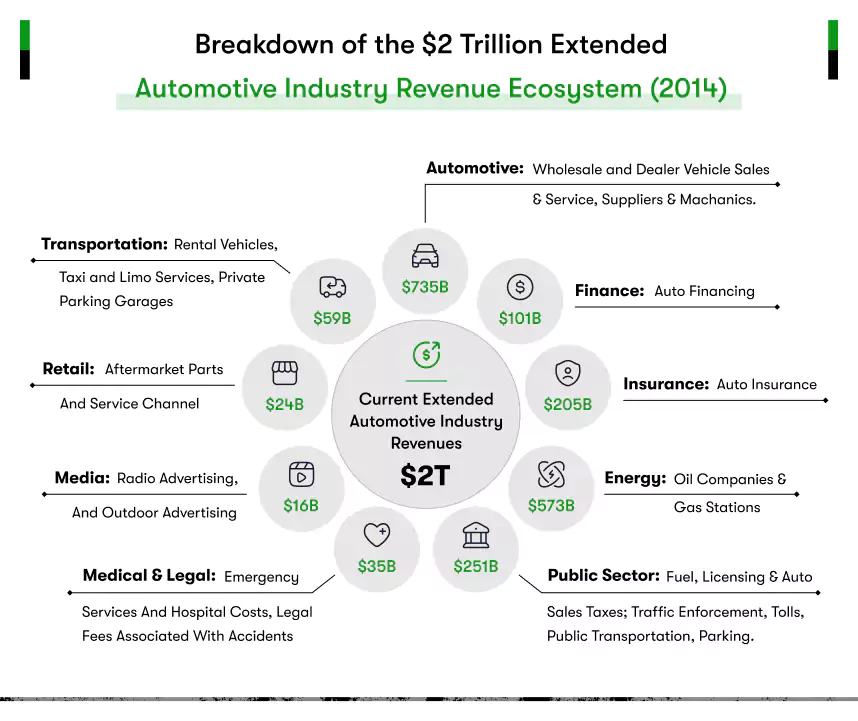
This highlights the industry’s importance but also its need for innovation to overcome issues like long design cycles, fragmented sales interactions, and costly training methods.
Vision Pro apps use powerful features such as 3D visualization, real-time collaboration, and spatial computing. These tools help designers make faster decisions, sales teams deliver engaging demos, and trainers provide safer, more effective learning.
Adopting Vision Pro apps is essential for CEOs, CTOs, and technical leaders who want to improve productivity, reduce costs, and accelerate innovation. These improvements lead to faster time-to-market, increased customer satisfaction, and lower operational expenses, giving companies a critical edge in a competitive market.
Keep reading to discover how Vision Pro apps transform automotive design, sales, and training with real-world examples and actionable insights.
Why Are Automotive Leaders Betting Big on VisionOS?
You need powerful solutions to tackle challenges in design, sales, and training. Vision Pro for the automotive industry offers exactly that by combining immersive 3D visualization, spatial computing, and real-time collaboration. These features help your design team work efficiently on virtual vehicle models, cutting down long design cycles and expensive errors. With faster, more accurate decisions, you can bring products to market quicker while reducing development costs.
When it comes to sales, VisionOS for virtual car showroom experience lets you create interactive, personalized demos that build customer confidence. No longer limited by physical showrooms, you can:
- Reach a broader audience regardless of their location, expanding your market potential.
- Shorten sales cycles by providing detailed, immersive vehicle demonstrations that engage customers deeply.
- Increase conversion rates by offering personalized experiences tailored to individual buyer preferences.
Using Vision Pro applications for the automotive industry, you transform how customers explore vehicles, making your sales process more effective and scalable.
VisionOS in Automotive: Real Impact Across Design, Sales, and Training
Your training programs also benefit significantly from Vision Pro use cases in automotive training. By creating realistic virtual environments, VisionOS improves skill retention and cuts expenses linked to physical facilities and travel.
With these tools, you can:
- Deliver scalable, remote training programs that allow your workforce to learn anytime, anywhere.
- Reduce training costs by minimizing the need for physical facilities and instructor-led sessions.
- Accelerate employee onboarding and continuous skill development through engaging, hands-on simulations.
Incorporating automotive app development using VisionOS means your teams stay skilled and agile, ready to meet evolving operational demands.
In summary, Vision Pro for the automotive industry drives productivity, lowers costs, and accelerates innovation across design, sales, and training. This technology supports your core business functions and helps you maintain a competitive edge in today’s automotive market.
If you’re looking to hire expert developers for your VisionOS projects, be sure to read our comprehensive guide, How to Hire VisionOS App Developers.
Redefining Automotive Design with Vision Pro for Automotive Industry
VisionOS is revolutionizing how you design vehicles by streamlining the entire process from concept modeling to virtual validation, enabling faster, more precise, and collaborative workflows.

Here is how it benefits your design process:
- Interactive 3D Modeling: VisionOS for automotive design allows you to create detailed, manipulable 3D models from initial sketches. You can explore every angle and feature in a virtual space, making your concepts easier to visualize and refine.
- Collaborative Real-Time Design: Vision Pro enables multiple team members to work on the same model simultaneously, regardless of location. This collaboration reduces delays and misunderstandings by allowing instant feedback and faster decision-making.
- Accelerated Design Process: With VisionOS, you reduce the need for physical prototypes by validating designs virtually. You save time and money through fewer costly iterations and faster innovation cycles.
- Virtual Validation Tools: You can simulate real-world conditions like aerodynamics, ergonomics, and structural performance before creating physical models. This early validation improves design accuracy and reduces rework during production.
Using VisionOS in your automotive design improves innovation speed, lowers costs, and enhances product quality. Staying updated with the latest Apple Vision Pro trends ensures your business maintains a clear advantage in the market.
Vision Pro Use Cases in Automotive Training: Smarter, Faster, Safer
Training is essential to maintaining safety and quality in the automotive industry. Vision Pro technology transforms training by making it more immersive, efficient, and safe. Here’s how Vision Pro enhances key training areas:
Virtual Reality Driver Training for Customers
Vision Pro enables customers to practice driving in a realistic virtual environment. This type of training exposes drivers to challenging scenarios that are hard to replicate in real life. It helps build confidence and improves safety awareness, which leads to fewer accidents on the road. For example:
- Customers can safely experience emergency situations, such as sudden braking or slippery roads, improving their reaction times in real life.
- The virtual training environment allows repeated practice, helping drivers master difficult maneuvers before getting behind the wheel.
- This method reduces the risk and cost associated with traditional driver training programs.
Hands-On Technician Training Without Vehicle Damage Risk
Technicians can gain valuable experience by working on virtual vehicles, eliminating the risk of damaging expensive equipment. Vision Pro provides a safe space to practice repairs, diagnostics, and maintenance. The benefits include:
- Technicians can repeat complex repair procedures multiple times until they achieve full proficiency without using physical vehicles.
- The virtual environment allows trainees to learn troubleshooting steps and maintenance routines safely, increasing their confidence.
- This training reduces downtime and repair costs while speeding up the learning curve for new technicians.
Dealer and Service Center Workforce Training via Immersive Scenarios
Dealership and service center staff can engage in immersive, realistic training that simulates customer interactions and service challenges. Vision Pro allows consistent training delivery across multiple locations, improving service quality. The advantages include:
- Employees can practice resolving customer complaints and handling service requests in a controlled environment.
- The immersive scenarios help develop problem-solving and communication skills that translate to better customer satisfaction.
- Training modules can be updated and distributed quickly, ensuring all locations follow the latest best practices.
With automotive app development using VisionOS, you can create customized training programs tailored to your company’s unique needs.
Just as the Vision Pro real estate app solution revolutionizes property viewing experiences, Vision Pro for automotive industry training helps reduce costs, improve workforce skills, and increase operational efficiency.
This technology empowers your staff and customers, positioning your business for long-term success in a competitive market.
Real-World Vision Pro Use Cases in Automotive Industry Training and Engagement
Leading automotive brands use Vision Pro to enhance design accuracy, provide immersive training, and improve customer engagement. These real-world applications demonstrate how Vision Pro transforms workflows, boosts efficiency, and creates interactive experiences across the automotive industry.
1. Porsche Race Engineer App: Enhancing Real-Time Performance Monitoring
Porsche launched the Race Engineer app on VisionOS to give engineers real-time access to critical vehicle data during races. Using immersive spatial computing, engineers monitor speed, braking, and track conditions directly through Vision Pro.
This tool helps the team make instant adjustments to optimize performance. When Porsche set a U.S. record with the Taycan Turbo GT at Laguna Seca, Vision Pro’s capabilities played a crucial role in that success.
Porsche’s Race Engineer app on VisionOS helped reduce decision-making time by 30%, resulting in a record-breaking lap at Laguna Seca.
If you want to boost real-time decision-making and vehicle performance, this app sets a strong example of Vision Pro applications for the automotive industry.
2. Audi’s Immersive Virtual Vehicle Customization
Audi has embraced VisionOS for automotive design by partnering with Unity to develop a virtual showroom experience on Vision Pro. This immersive platform lets customers explore and customize vehicles in a detailed 3D environment.
With interactive features, buyers can personalize paint colors, interiors, and wheels, creating a unique connection to their vehicle before purchase.
Audi reported a 25% increase in customer engagement after launching their Vision Pro virtual showroom experience.
This use case highlights how Vision Pro for the automotive industry can elevate your sales process through engaging digital showrooms.
3. Appsfactory’s Interactive Car Configurator
Appsfactory’s VisionOS car configurator allows you to visualize vehicle customization using RealityKit. The app provides a hands-on experience where users modify vehicle features like doors, rims, and paint colors in real-time 3D.
This technology is an excellent example of automotive app development using VisionOS to improve customer engagement and streamline the buying journey.
Integrating such apps into your sales strategy can significantly enhance customer satisfaction and sales conversion.
4. Cubix’s Virtual Test Drive and Remote Exploration
Cubix offers immersive virtual test drives on VisionOS, enabling customers to explore vehicles remotely with high realism. This technology allows you to reach customers who prefer to experience cars from their homes.
This virtual test drive demonstrates how Vision Pro use cases in automotive training and customer engagement go beyond traditional boundaries, improving accessibility and convenience.
Incorporating such solutions can expand your market reach and provide a competitive edge.
These real-world applications show how Vision Pro for the automotive industry supports critical functions like design innovation, workforce training, and enhanced sales experiences.
If you want to understand the difference between Vision Pro and Meta Quest 3, check out our detailed blog, apple vision pro vs meta quest 3.
How Vision Pro for Automotive Industry is Transforming Virtual Car Showroom Experiences
Using VisionOS for virtual car showroom experience gives you the power to deliver a fully personalized, immersive journey for your customers that goes beyond traditional sales methods.

Personalized, Immersive Customer Journeys Anytime, Anywhere
With Vision Pro, you offer customers the ability to explore vehicles from their own space. This isn’t just looking at pictures or videos, your customers step inside the car virtually and interact with every detail. They can customize colors, trims, and features to see exactly what fits their style. This level of engagement builds trust and emotional connection, which are crucial for closing sales. Benefits include:
- Allowing customers to explore your entire vehicle lineup without visiting a showroom.
- Enabling them to customize and visualize features in real time.
- Creating memorable experiences that increase buyer confidence.
Virtual Test Drives and Interactive 3D Exploration of Car Features
Virtual test drives powered by VisionOS bring the excitement of driving to your customers’ fingertips. You can simulate realistic driving scenarios that help buyers understand how the car performs in different conditions. Additionally, interactive 3D models let them examine interiors, controls, and technology features up close. This hands-on interaction reduces hesitation and speeds up decision-making. Advantages for you are:
- Providing a safe, convenient way to experience vehicle performance.
- Allowing customers to interact deeply with car features and options.
- Helping buyers feel confident before scheduling a physical test drive or purchase.
Reducing Showroom Dependency Lowers Your Overhead and Widens Your Reach
Traditional showrooms require significant investments in space, staff, and maintenance. VisionOS-powered virtual showrooms reduce this dependency by allowing you to reach customers virtually anywhere.
This lowers your operational costs while expanding your potential market far beyond local limits. With automotive app development using VisionOS, you can deliver consistent, high-quality experiences to a global audience. Key impacts include:
- Cutting costs related to physical showroom spaces and staffing.
- Increasing your market reach to customers in different regions or countries.
- Offering flexible, on-demand vehicle exploration without time constraints.
Incorporating Vision Pro applications for the automotive industry into your sales strategy is essential if you want to modernize your approach. Converting your existing app to VisionOS unlocks the full potential of virtual showroom experiences, helping you attract more qualified leads, shorten sales cycles, and improve overall customer satisfaction. If you want to stay competitive and grow, investing in VisionOS virtual showrooms is a strategic move.
How to Build Cutting-Edge Automotive Apps with Vision Pro for Automotive Industry:
If you want to lead innovation in the automotive industry, building apps with VisionOS offers you a powerful platform designed to unlock new possibilities. Vision Pro for the automotive industry provides developers with advanced tools to create immersive and intelligent applications tailored to your business needs.
What VisionOS Offers for Developers in the Automotive Space
VisionOS delivers a rich environment where you can build interactive, spatial computing applications that blend the digital and physical worlds. This platform enables you to design apps that provide real-time data visualization, gesture controls, and immersive 3D interactions. As a developer or decision-maker, you gain access to:
- Advanced APIs for spatial awareness and user interaction.
- Seamless integration with hardware sensors and external devices.
- High-performance graphics rendering for detailed visualizations.
This foundation allows you to create innovative apps that enhance driver experience, improve vehicle management, and revolutionize customer engagement.
Key Integrations: IoT, AR, Vehicle Telemetry, and Real-Time Rendering
VisionOS supports multiple critical integrations that elevate automotive app functionality:
- IoT connectivity enables your app to communicate with smart vehicle components and external devices, creating a connected ecosystem.
- Augmented Reality (AR) features let you overlay digital information on real-world views, useful for navigation, diagnostics, and training.
- Vehicle telemetry integration provides real-time data streams from sensors, allowing monitoring of speed, fuel levels, tire pressure, and more.
- Real-time rendering delivers smooth, high-fidelity 3D visuals essential for interactive dashboards, virtual manuals, and immersive user interfaces.
These integrations let you build apps that are not just functional but intuitive and engaging.
Use Cases: Smart Dashboards, Remote Diagnostics, and Virtual Manuals
VisionOS opens up new possibilities for practical automotive applications:
- Smart dashboards present critical vehicle data in an immersive format, enabling drivers to access information through intuitive gestures and spatial displays. This improves safety and convenience on the road.
- Remote diagnostics apps allow technicians to receive and analyze vehicle telemetry remotely, facilitating faster troubleshooting and maintenance without physical vehicle inspections.
- Virtual manuals provide interactive, 3D guides that walk users or service staff through repairs and maintenance step-by-step, reducing errors and improving efficiency.
Leveraging automotive app development using VisionOS enables you to deliver advanced solutions that boost productivity, enhance user satisfaction, and create new revenue streams.
VisionOS empowers you to build cutting-edge automotive apps that combine immersive technology with practical functionality. When you submit VisionOS apps to the platform, you unlock opportunities to innovate, reduce costs, and provide unmatched experiences for drivers and technicians alike.

Top Vision Pro Applications for Automotive Industry in 2025 and Beyond
What are the leading Vision Pro applications reshaping the automotive industry today and in the future? Here’s a consolidated summary of cross-functional applications that impact design, sales, training, maintenance, and post-sales experience—all driving measurable business outcomes.
1. Design
- In the automotive industry, Vision Pro significantly improves how you approach design. It offers advanced tools that streamline workflows, making the design process faster and more precise.
- Interactive 3D modeling with spatial computing for accurate concept visualization.
- Real-time collaboration across teams regardless of location, speeding up decision-making.
- Virtual validation tools to simulate physical tests, reducing costly prototypes and iterations.
2. Sales
VisionOS transforms automotive sales by creating immersive, flexible customer experiences. These tools help your sales team engage buyers more effectively and close deals faster.
- Personalized, immersive customer journeys accessible anytime, anywhere.
- Virtual test drives and interactive 3D exploration of vehicle features to increase buyer confidence.
- Reduced reliance on physical showrooms, lowering overhead and expanding market reach.
3. Training
Training in the automotive sector becomes safer and more efficient with Vision Pro applications. You can provide hands-on learning experiences without the traditional risks or costs.
- Virtual reality driver training for customers, improving safety and skill retention.
- Hands-on technician training without risk to real vehicles, speeding up skill acquisition.
- Immersive dealer and service center workforce training for consistent, scalable knowledge transfer.
4. Maintenance
Maintenance processes benefit greatly from Vision Pro’s advanced capabilities. You gain tools that help technicians diagnose and repair vehicles faster and with higher accuracy.
- Remote diagnostics through real-time telemetry monitoring and AR overlays for quicker repairs.
- Virtual manuals offer step-by-step 3D guides for technicians, reducing errors and downtime.
5. Post-Sales Experience
After purchase, Vision Pro applications keep customers engaged and satisfied. You provide support and education through immersive, interactive experiences that build loyalty.
- Offering virtual assistance for vehicle features and maintenance scheduling.
- Enabling immersive experiences for new feature walkthroughs and upgrades.
Embracing these innovative solutions through expert vision pro app development allows you to stay ahead in the competitive automotive market by delivering immersive, efficient, and scalable experiences across design, sales, training, maintenance, and post-sales support.
Challenges & Considerations for Auto Leaders Before Adopting Vision Pro
Understanding the key challenges in adopting Vision Pro for the automotive industry, such as hardware costs, user onboarding, safety compliance, app scalability, and security is essential for automotive leaders to implement the technology successfully and maximize its business benefits.
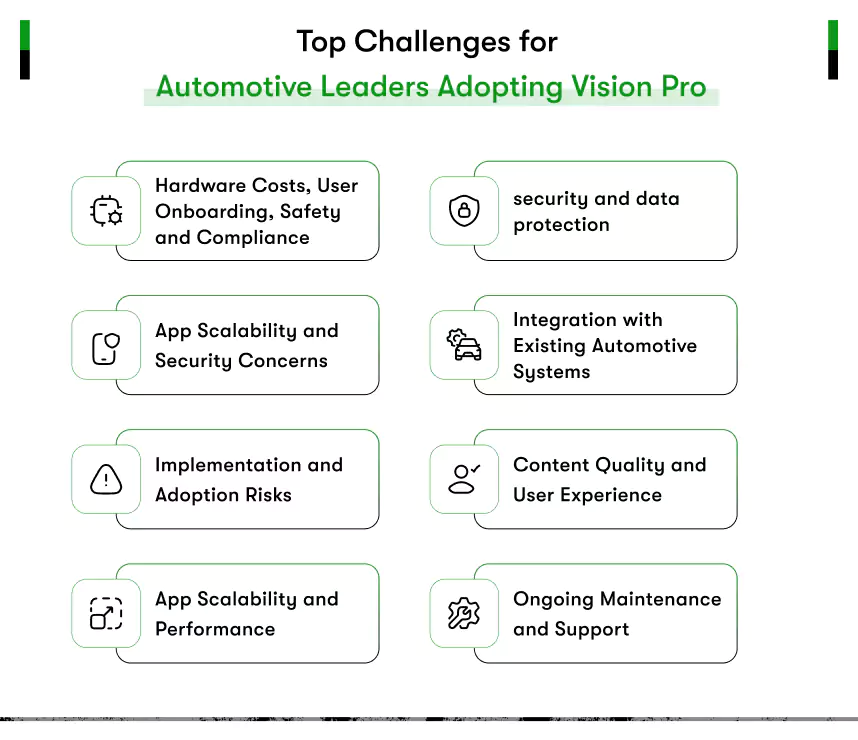
1. Hardware Costs, User Onboarding, Safety & Compliance
Investing in Vision Pro requires significant hardware costs, which you need to budget carefully. Additionally, user onboarding is essential to maximize adoption and minimize resistance. Safety and compliance cannot be overlooked, as automotive regulations are strict and evolving. Consider:
- Planning for upfront device purchases and ongoing maintenance expenses.
- Creating effective training programs that help your teams and customers quickly adapt to Vision Pro apps.
- Ensuring all applications comply with automotive safety standards and data privacy laws.
2. App Scalability and Security Concerns in Automotive
As your Vision Pro applications grow, scalability and security become critical. Your apps must handle increased data and user load without performance issues while protecting sensitive vehicle and customer information. Important points include:
- Designing scalable app architectures to accommodate growth in users and data.
- Implementing advanced cybersecurity protocols to safeguard telemetry and personal data.
- Conducting frequent security audits and updates to stay ahead of vulnerabilities.
3. Implementation and Adoption Risks
Leading automotive companies adopt strategic approaches to overcome Vision Pro adoption hurdles. They start with pilot programs and collaborate closely with technology partners to ensure success. Key tactics include:
- Launching small-scale trials to collect feedback and optimize user onboarding.
- Partnering with specialized developers familiar with automotive app development using VisionOS to build secure and scalable solutions.
- Continuously monitoring regulatory changes to maintain compliance and update applications accordingly.
4. App Scalability and Performance
As your use of Vision Pro expands, your applications must scale efficiently without compromising performance. Failing to plan for scalability can lead to system crashes and poor user experiences. You need to:
- Design your Vision Pro apps with scalable architectures to handle growing numbers of users and data streams from vehicle telemetry.
- Regularly monitor app performance and conduct stress tests to identify bottlenecks early.
- Collaborate with experienced developers specializing in automotive app development using VisionOS to ensure your applications remain reliable under load.
5. Security and Data Protection
Protecting sensitive vehicle telemetry and customer information is paramount in Vision Pro deployments. You should:
- Implement advanced encryption and secure authentication mechanisms within your Vision Pro apps to prevent unauthorized access.
- Perform regular security audits and penetration testing to uncover vulnerabilities.
- Educate your teams about cybersecurity best practices specific to Vision Pro applications to minimize risk.
6. Integration with Existing Automotive Systems
Vision Pro applications must seamlessly integrate with your current automotive systems to provide a unified and efficient workflow. Important steps include:
- Ensuring compatibility with IoT platforms, vehicle diagnostic tools, and customer relationship management systems.
- Planning for smooth data synchronization to prevent inconsistencies and errors.
- Partnering with experts in automotive app development using VisionOS who understand the complexities of your existing technology stack.
7. Content Quality and User Experience
Delivering immersive, high-quality content is crucial for user engagement. You must:
- Invest in creating detailed 3D models and smooth interactive experiences within your Vision Pro apps.
- Conduct user testing regularly to refine interfaces and interactions, especially in VisionOS for automotive design tools.
- Update your content frequently to maintain relevance and user interest.
8. Ongoing Maintenance and Support
Maintaining your Vision Pro applications requires a commitment to continuous improvement. You should:
- Schedule regular software updates and bug fixes to keep your Vision Pro solutions secure and efficient.
- Provide responsive technical support services to quickly resolve user issues and minimize downtime.
- Collect and analyze user feedback to guide future enhancements in your Vision Pro applications for the automotive industry.
Understanding and addressing these challenges such as hardware investments, onboarding, scalability, and security is essential for successfully adopting Vision Pro for automotive industry technology.
To navigate these complexities effectively and maximize your return, it is wise to hire VisionOS app developers who specialize in automotive solutions and can deliver secure, scalable, and compliant applications.
Final Thoughts: Why Automotive CEOs & CTOs Should Prioritize Vision Pro Now
The automotive industry is at a pivotal moment. Vision Pro for automotive industry offers unprecedented opportunities to innovate across design, sales, training, and maintenance. If you want to stay competitive, reduce costs, and accelerate your time-to-market, embracing Vision Pro technology is no longer optional, it’s essential.
Kody Technolab, a leading VisionOS App Development Company, specializes in creating tailored, secure, and scalable Vision Pro applications for automotive businesses. Our expert team helps you navigate challenges, ensuring seamless integration and delivering solutions that maximize your ROI.
Don’t let your competitors leave you behind. Now is the time to act. Reach out to a professional VisionOS app development team to start transforming your automotive business today. Your investment in Vision Pro will drive growth, improve customer experiences, and secure your leadership in the rapidly evolving automotive market.
FAQs: Vision Pro for Automotive Industry
Q1: What new capabilities does Vision Pro bring to the automotive tech market?
Vision Pro introduces immersive spatial computing with features like advanced 3D visualization, real-time collaboration, and precise spatial tracking. For automotive businesses, this means faster design cycles, enhanced remote training, and interactive sales demos that improve customer engagement and operational efficiency.
Q2: What technology powers Vision Pro and why does it matter for automotive companies?
Vision Pro leverages spatial computing, augmented reality (AR), and high-performance graphics rendering, combined with sensors for real-world environment mapping. This technology enables automotive companies to create highly interactive and realistic apps that improve design accuracy, accelerate training, and provide immersive customer experiences.
Q3: How can Vision Pro improve my automotive business operations?
Integrating Vision Pro applications helps you streamline complex design workflows, reduce costly physical prototyping, enhance sales presentations with virtual showrooms, and deliver safer, more effective training programs. This results in reduced costs and faster time-to-market.
Q4: What are the key considerations before adopting Vision Pro technology?
You should evaluate hardware investments, app scalability, user onboarding, safety compliance, and data security. Early planning and partnering with experienced Vision Pro app developers are crucial to overcome these challenges and ensure successful deployment.
Q5: How does Vision Pro compare to other XR platforms for automotive use?
Vision Pro stands out for its spatial computing capabilities, seamless integration with Apple’s ecosystem, and high-fidelity 3D rendering. This translates into more immersive and accurate automotive applications than many other XR platforms currently available.
Q6: What is the typical cost involved in implementing Vision Pro solutions?
Costs depend on the scale and complexity of your Vision Pro implementation. Development expenses vary widely. A basic app might cost around $50,000, while more complex applications involving IoT, AR, and real-time telemetry can exceed $250,000.
Additional costs include onboarding, training, and ongoing maintenance. Partnering with an experienced VisionOS app development company helps you plan your budget efficiently and ensures you achieve the best return on investment tailored to your business needs.
Q7: What kind of return on investment (ROI) can I expect from Vision Pro applications?
ROI depends on use cases but often includes faster design cycles, reduced prototyping expenses, improved sales conversions, and lower training costs. Early adopters report significant efficiency gains and enhanced customer engagement, which contribute to measurable business growth.
Q8: How long does it take to develop and deploy Vision Pro automotive apps?
Development timelines depend on app complexity, features, and integrations. Simple apps may take a few months, while complex applications involving IoT or real-time telemetry could take longer. Working with a skilled VisionOS app development company ensures timely delivery with high-quality outcomes.
Q9: Can Vision Pro applications integrate with existing automotive systems and IoT devices?
Yes. Vision Pro supports integration with vehicle telemetry, IoT platforms, diagnostic tools, and CRM systems. Proper integration enables seamless workflows and comprehensive data utilization, maximizing the value of your Vision Pro investments.
Q10: What support and maintenance should I plan for after launching Vision Pro apps?
Ongoing support includes regular software updates, security patches, user training, and technical assistance. Budgeting for continuous maintenance ensures your Vision Pro applications stay secure, compliant, and perform optimally as technology evolves.

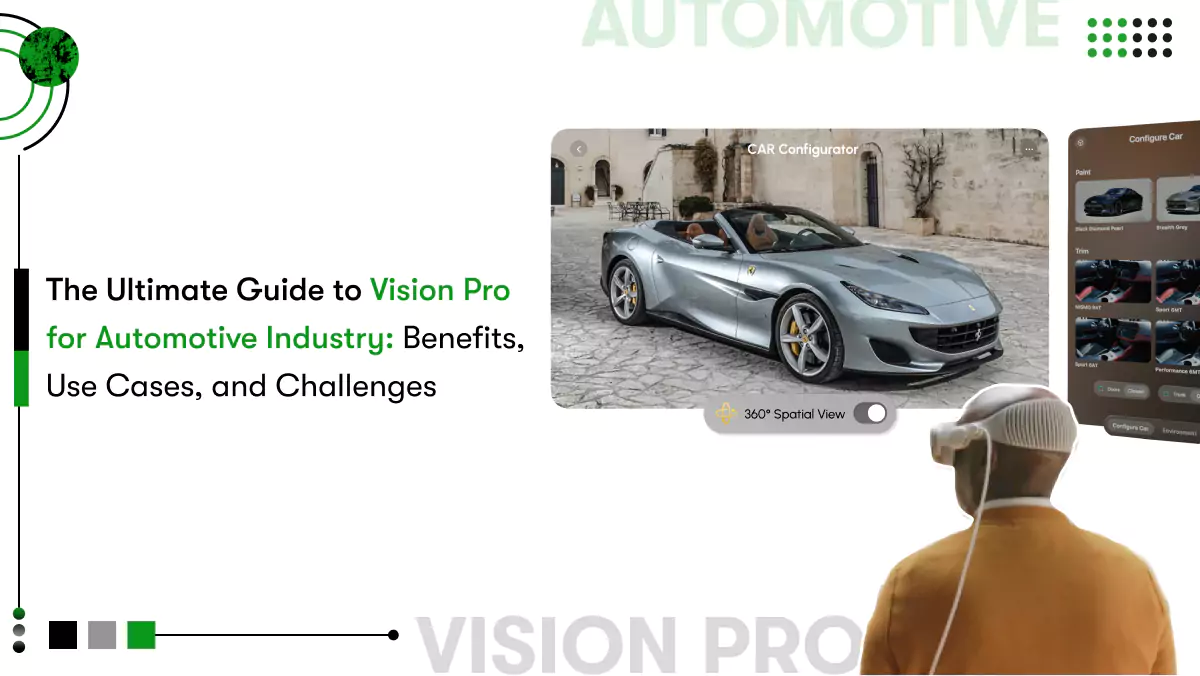
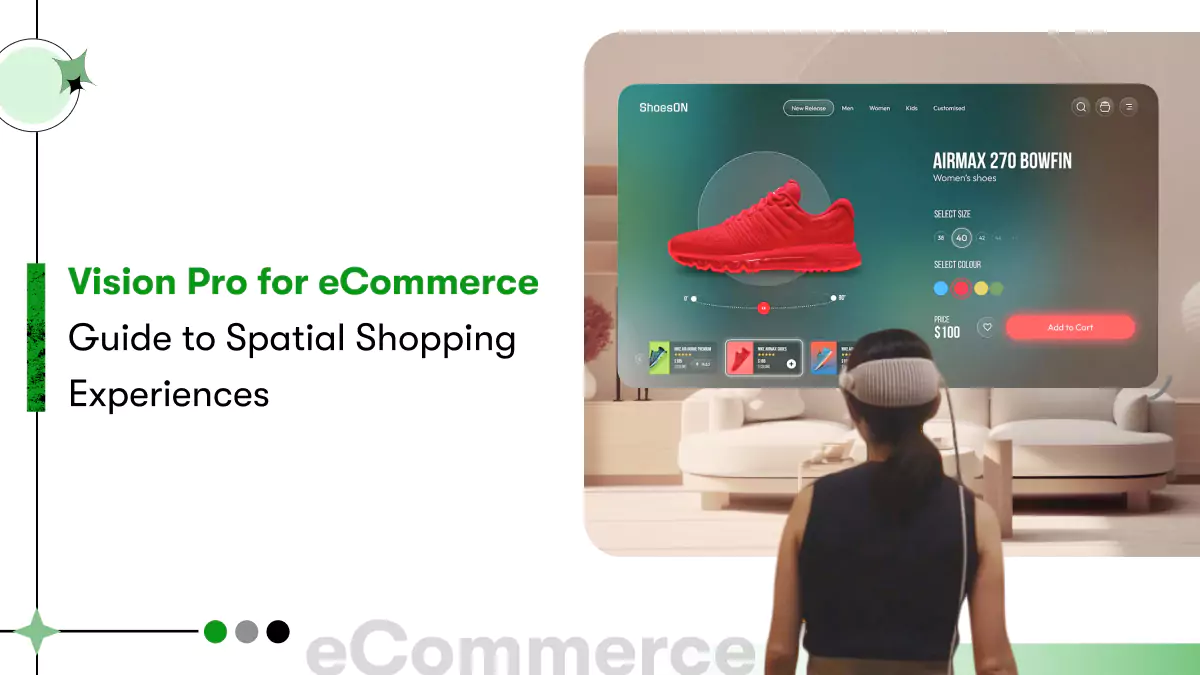
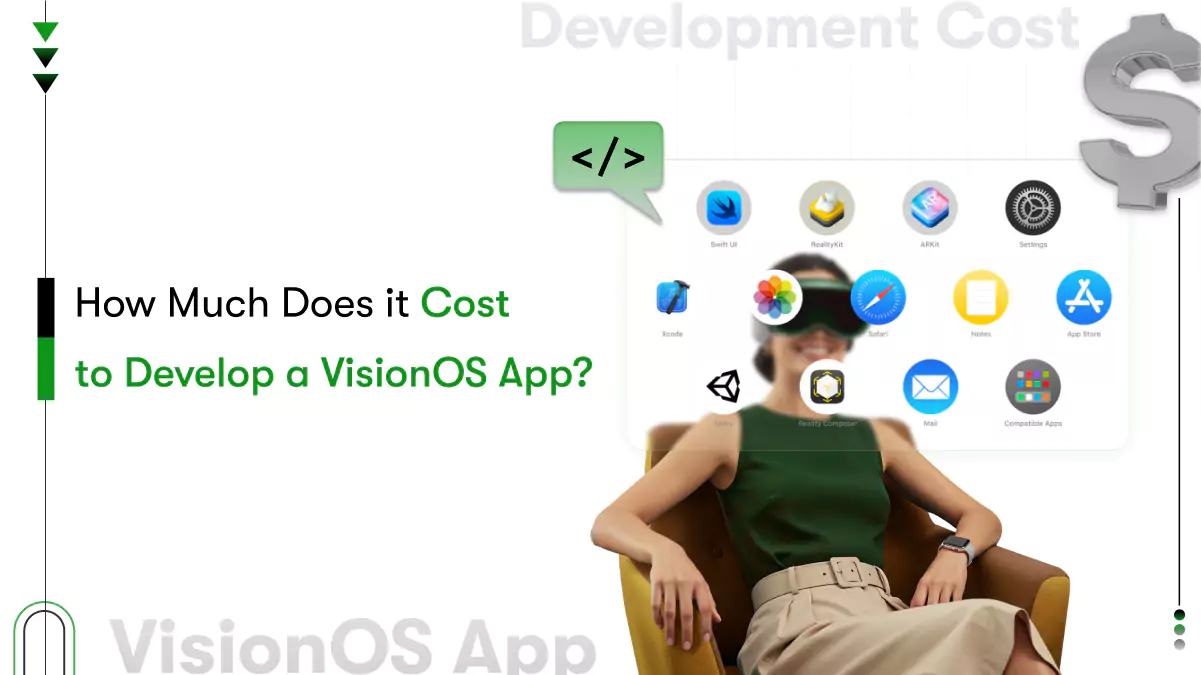
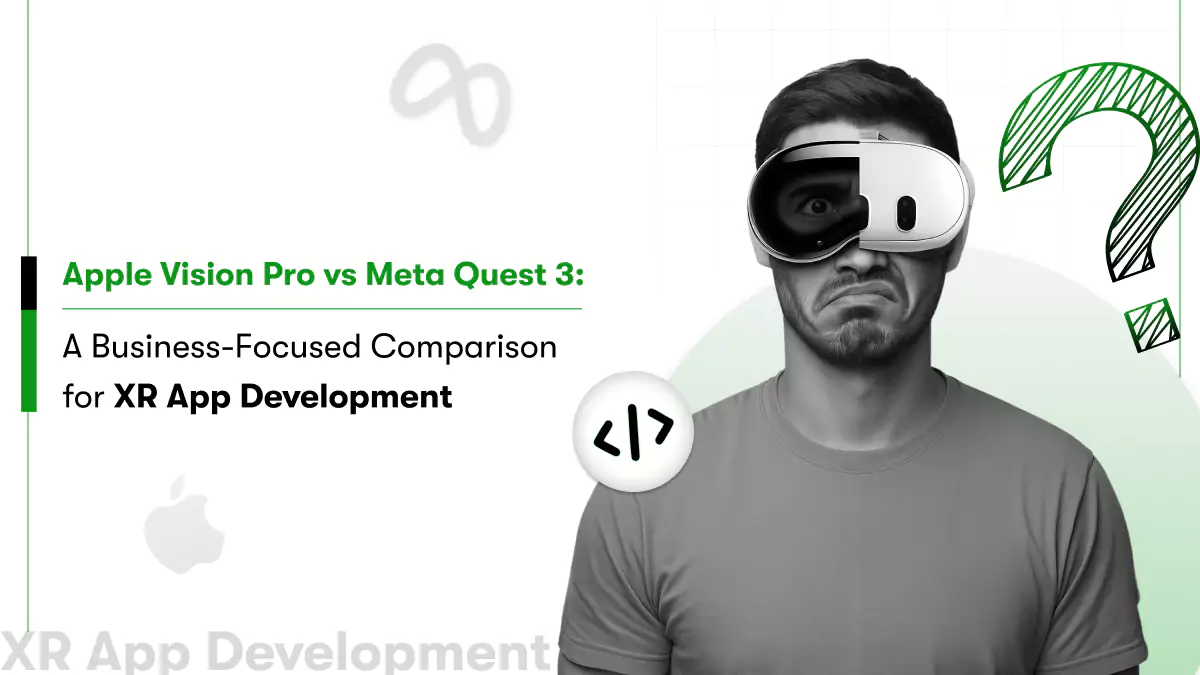
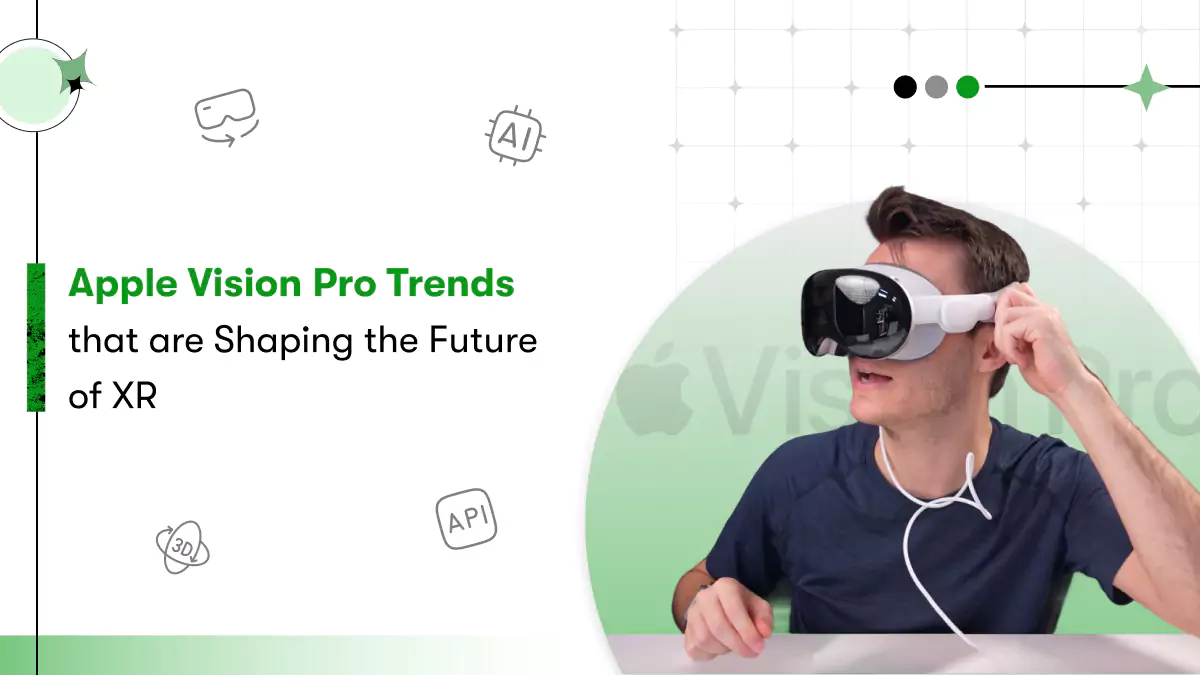
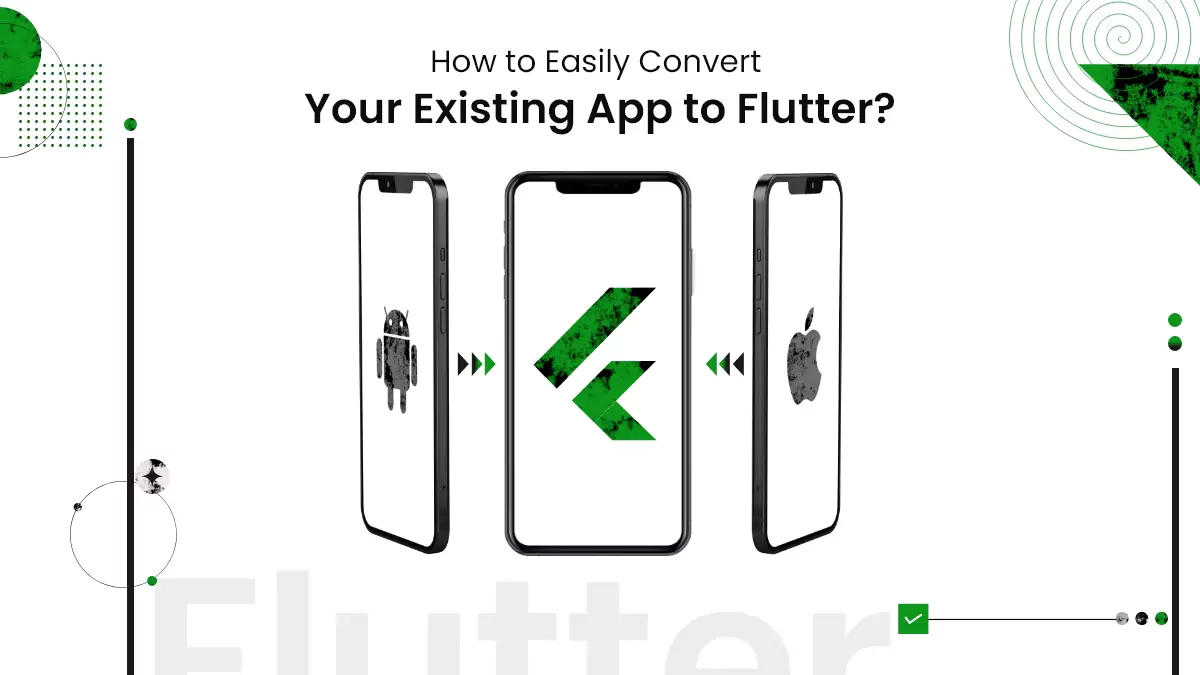





 Contact Information
Contact Information